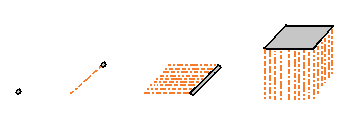
 |
The diagram above portrays a well-known technique for introducing spatial dimensions. One starts with a point. 'Higher-dimensional' structures are then formed by "gliding" the current structure at a right angle to itself, leaving a "trail" behind in the process - as you can see. Once a cube is formed, however, a problem appears: how does one move / 'glide' a cube in a direction perpendicular to itself? What does it mean to be at a right angle to a cube? How does one express such a direction?
If a cube were in fact "glided" perpendicular to itself, the result would be a 4-dimensional object known as the hypercube (that is, a 4-dimensional cube) - which we will attempt to 'glide' later in a similar fashion. Let us alter / modify the above diagram to suit our needs:
 |
In the diagram shown here, the structures portrayed in the top diagram are presented in the form of everyday objects. This diagram, rather than viewing each structure as a single, unbroken "unit" (as is done in the diagram at the top of the page), shows that the structures can be expressed in the form of an array of lesser units. It is the accumulated thickness of these lined-up 'lesser units' that is responsible for the formation of the structure. As they accumulate, they extend into the same direction that the 'trail' would extend into, were the 'gliding' technique used. Thinking in terms of 'stacks' / 'arrays' can prove to be a powerful tool when dealing with 'higher spaces'.
If a Linelander, for example, whose entire existence is limited to a line, wanted the second dimension explained to him, what would we tell him? We know as a fact that a Linelander can comprehend nothing above a line. Yet we would be successfully explaining the second dimension to him if we told him that the second dimension was simply an array of lines - which it is. It is in 'stacking' line upon line that the lines accumulate and form a square: "the second dimension can be thought of as the result of 'rows of segments' being stacked upon each other and accumulating". Though a square could be described in better detail, this version - consisting of lined-up 'lesser units' - is a "working model" that the Linelander can understand.
The same approach could be taken toward a Flatlander, whose entire existence is limited to a mere length and width, wanting the third dimension explained to him: "the third dimension can be thought of as the result of 'rows of squares' being stacked upon each other and accumulating". And what of our own dimension? "Rows of cubes"? And if so, in what direction? That is the purpose of Visualizing 4-space.
| to previous section |
to table of contents |
to next section |
||
| Comments, questions, feedback: [email protected] |